Evolution of some Powerful European Types
LOCOMOTIVES - 36
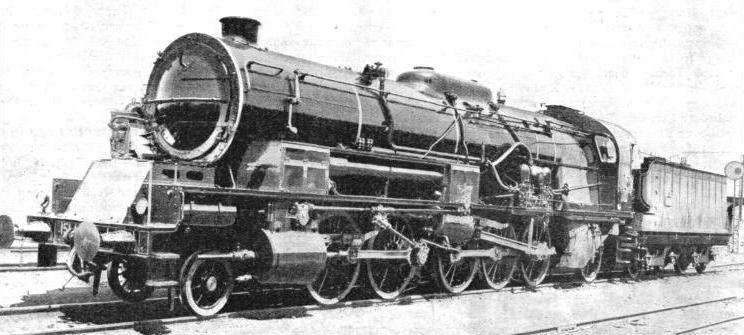
FOR HEAVY FREIGHT SERVICE ON FRENCH LINES. This 2-10-2 four-cylinder compound, built for the PLM in 1932, has the second and third pairs of coupled wheels connected by coupling rods working between the frames on cranked axles. The high-pressure cylinders measure 19-in by 25-in, and the low-pressure cylinders 29¼-in by 27½-in. The total heating surface is 3,662 sq ft, the grate area 54 sq ft, and the diameter of the driving wheels 4 ft 11-in. Engine and tender weigh 183 tons.
EUROPEAN locomotive practice has throughout its history been largely bound up with the development of compounding. Another chapter describes “The Evolution of Compounds”, chiefly in Great Britain, and refers to the fact that in the years 1903 and 1905 three four-cylinder compound locomotives which had been built in France were acquired by the Great Western Railway for trial purposes. This acquisition was in itself a tribute to the reputation of the French compounds at that time. For various reasons the Great Western Railway, after comparative trials had been made, kept to simple propulsion: but it is probable that certain features of GWR locomotive practice - high working pressures and long valve-travels in particular - may be traced back to lessons learned from these visitors.
It was probably on the Northern Railway of France that French locomotive practice in the early part of this century established its chief claims to distinction. Two eminent locomotive engineers were concerned - A. G. de Glehn and his successor, G. du Bousquet - who established the compound locomotive practice that is jointly associated with their names, and laid a foundation on which practically every French railway has since built.
In its lay-out the French locomotive would probably be regarded as a most complicated machine by the average British driver. An essential feature of the de Glehn-du Bousquet compound arrangement is four independent sets of Walschaerts valve-motion, and independent cut-off adjustment for both sets of cylinders, so that the driver has two reversing gears to control as well as the opening of his regulator. In other ways the average French footplate, with its mass of controls, looks a considerably more complex affair than the average footplate in Great Britain. But the French driver appears to thrive on complications, and it is largely to his traditional driving skill that the success of locomotive compounding in France has been due.
Records show that as far back as 1900 the Nord compounds were already putting up remarkable performances. In that year a 4-4-0 compound ran the 95·1 miles from Paris to St. Quentin, with the “Nord Express”, in 85¼ minutes; the best schedule to-day is 88 minutes. Loads, of course, were light in those days, and the weight of the train amounted to only 113 tons. Up the 1 in 200 to Survilliers speed was maintained at 67, and the train travelled on the level at 76 miles an hour.
In 1902, the first of the famous four-cylinder compound “Atlantics” appeared, and soon had some notable journeys to their credit. One of them, with 246 tons behind the tender, covered the 184·2 miles from Calais to Paris in 173 minutes - fourteen minutes less than the present schedule of the down “Golden Arrow”, and twenty-seven minutes less than the booking of the train concerned. Another, with 158 tons, ran the 157½ miles from Boulogne to Paris in 145 minutes, inclusive of a stop of five minutes at Abbeville for water, reaching speeds as high as 87 miles an hour on falling gradients. On a further occasion one of the “Atlantics” took a 140-tons train right over Survilliers Summit, with its approach grade of 1 in 200, without the speed falling below 74½ miles an hour. It is small wonder that such performances attracted attention in England, for many of them were made on the boat services between Paris, Boulogne, and Calais.
The compound “Atlantics” held the field for many years, and are still employed on some of the secondary services. But the increasing weight of the trains over the principal routes soon began to call for the provision of six-coupled wheels.
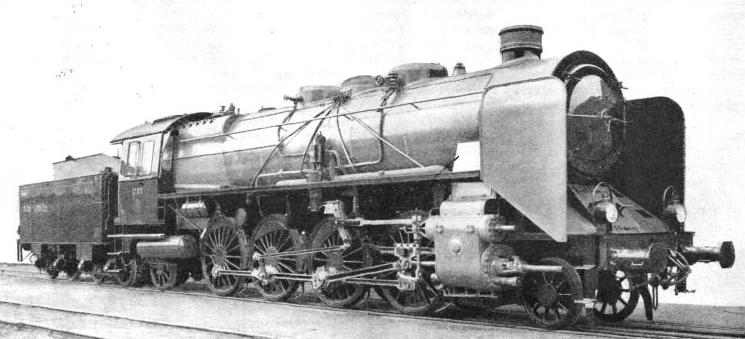
TYPICAL GERMAN PRACTICE. This 2-8-2 express engine, operating on the German State Railways, is an excellent example of Continental locomotive design. The tail-rodding for both piston valves and piston should be noted. The drive is on the second instead of the third axle - a feature found also on the LNER 2-8-2 locomotive “Cock o' the North”.
Experiments were made in 1910 with two 4-6-4 express engines with what were, for that period, exceptional dimensions, as they measured 80 ft 10½-in over buffers, and weighed 100½ tons without, and 156 tons with their tenders. One of them had a water-tube firebox of novel design. But they were before their time, and the year 1912 witnessed the emergence of the first four-cylinder compound Nord “Pacifics” of what has since become a lengthy series.
There have been three successive enlargements of this class, and the latest examples, numbered from 1201 to 1290, are very powerful machines. After the war of 1914-1918 the French Government endeavoured to standardize the “Pacific” type then in use on the State lines, and numbers of these engines were supplied to the Est and other railways. But the Nord stuck tenaciously to its own designs, and in particular to the long narrow firebox that is one of the principal characteristics of Nord “Pacifics”. These locomotives have boilers of 5 ft 9-in diameter, giving a total heating surface of 2,440 sq ft, to which must be added the superheating surface of 615 sq ft. Working pressure is 227 lb per sq in. The two outside cylinders are the high-pressure cylinders, 17¼-in in diameter by 26-in stroke, operated by piston-valves, while the low-pressure cylinders are between the frames, 24½-in in diameter by 27-in stroke, with balanced slide-valves. In weight the engine totals 96¾ tons, or almost exactly the same figure as one of the high-pressure “Pacifics” of the LNER. The “ACFI” feed-water heater is carried on the top of the boiler, and is entirely automatic and self-regulating in its action. The initials “ACFI” are those of the Compagnie des Auxiliaires des Chemins de Fer et de l'Industrie, that is the Railway and Industrial Accessories Company.
Remarkable Hill-Climbing
During 1935 the express passenger locomotive stock of the Northern Railway of France was strengthened by the transfer from the Paris-Orleans Railway of twenty rebuilt “Pacifics” of the latter company, of the type which is described in detail later in this chapter.
Two other notable locomotive types have been introduced recently by the Nord. One is a series of 2-10-0 freight locomotives, of which thirty have been built. They are, of course, four-cylinder compounds, with the outside high-pressure cylinders 19¼-in diameter by 25¼-in stroke, and the inside low-pressure cylinders 26¾-in diameter by 27½-in stroke. Each outside cylinder is cast in one piece with the front end of the frame, and the two inside cylinders are formed as one casting. Driving wheels are 5 ft 1-in in diameter. Heating surface totals 2,108 sq ft, and superheating surface 656 sq ft; firegrate area is 37½ sq ft, and working pressure 261 lb per sq in. In working order these powerful locomotives, without tenders, weigh 102¼ tons each. They are designed for the haulage of coal trains weighing 2,165 tons at 40 miles an hour on level track.
The other is a 2-8-2 type tank locomotive for suburban service, in which simple propulsion is used. These engines have 25¼ by 27½-in cylinders, 5 ft 1-in coupled wheels, 33½ sq ft of fire-grate area, and 261 lb per sq in working pressure. With their tank and bunker capacity of 2,200 gallons of water and 5 tons of coal respectively, they weigh 120 tons each in running trim. On test one of these locomotives performed some remarkable feats, such as accelerating a train of 480 tons weight up a 1 in 200 gradient to no less than 70 miles an hour, and of maintaining 75 miles an hour on the level with this load, notwithstanding eight-coupled wheels of no more than 5 ft 1-in diameter. Cam-operated Cossart valves to the cylinders are used. The suburban services round Paris, which require heavy trains and have relatively fast timings, provide suitable occupation for these locomotives.

REBUILT “PACIFIC” LOCOMOTIVE on the Paris-Orleans Railway. The 4-6-2 type of engine was introduced into France by this line in 1907. Reconstruction of earlier “Pacific” locomotives began in 1929. The remarkable success of these rebuilt engines, working with enlarged steam passages, new valves, and a high degree of superheat, has greatly influenced French locomotive practice.
The Paris, Lyons and Mediterranean Railway has always been notable for its large and powerful engines. It was one of the first French companies, after the Paris-Orleans Railway, to introduce “Pacific” locomotives. Hundreds of PLM “Pacifics” have been built since the first were brought out in 1909. By way of preliminary, a four-cylinder compound was tried against a four-cylinder simple, and a substantial victory was won for compound propulsion. Later, the engines were superheated, with a further increase in efficiency. In more recent years the methods of rebuilding which have proved so successful on the Paris-Orleans Railway have been followed on the PLM with equally striking results.
But the PLM has some very heavily graded sections of line, in particular that between Dijon and the Swiss frontier at Vallorbe. There is also the southward ascent from Dijon on the main line to Paris, which for 9¼ miles of the distance to Blaisy-Bas, 16½ miles away, is inclined at 1 in 125. Over this route a dense traffic is worked, particularly at night, express trains of great weight succeeding one another at intervals of roughly ten minutes. It is essential that the locomotives used shall be powerful and reliable, for one train losing time may delay a succession of others.
For this reason the PLM introduced a class of enormous “Mountain” (4-8-2) type express engines in 1925, each weighing 115 tons without, and 185 tons with tender. The diameter of the driving wheels was kept down to 5 ft 11-in, to give the necessary power uphill, and in consequence the maximum speed of these engines has been generally restricted to 100 kilometres (62 miles) an hour, though this by no means represents the limit attainable.
Externally they are notable both for their length and for the coned smoke-box door, projecting well in front of the chimney, the idea being to carry the exhaust high above the front of the cab.
Tractive Effort of 65,960 lbs
Experimentally one engine of this class has been built with the Schmidt super-pressure type of boiler, working at a pressure of 1,000 lb per sq in. With a view to developing higher speeds, another “Mountain” has been built with driving wheels 6 ft 5-in in diameter. Neither variation of the standard class has been multiplied.
Another remarkable type of locomotive was turned out by the PLM Railway in 1932 for heavy freight service, and incorporates certain unique features. Externally the wheel arrangement appears to be 2-4-6-2; but the engine is a 2-10-2, with the second and third pairs of coupled wheels connected by coupling rods working between the frames on cranked axles. All four cylinders of this 2-10-2, which is, as usual, a four-cylinder compound, are outside the frames. The high-pressure cylinders, 19-in diameter by 25-in stroke, drive the rear group of externally coupled wheels, and the low-pressure cylinders, 29¼-in diameter by 27½-in stroke, the front group, thus giving the engine a distinctly “articulated” appearance. It is illustrated at the head of this chapter. With a total heating surface of 3,662 sq ft, a fire-grate area of 54 sq ft, driving wheels 4 ft 11-in in diameter, and a theoretical tractive effort of 65,960 lb, engines of this type are extremely powerful machines. Each one weighs 120½ tons without, and 183 tons with tender, which accommodates 7 tons of fuel and 6,160 gallons of water.

TO WORK TRAFFIC OVER SEVERE GRADIENTS on the main lines through Central France, 4-8-0 locomotives of the type illustrated were converted by the Paris-Orleans Railway from an earlier type of “Pacific”. These highly successful engines have two high-pressure and two low-pressure cylinders, driving wheels of 5 ft 11-in diameter, a total heating surface of 2,252 sq ft, a fire-grate area of 40 sq ft, and a working pressure of 290 lb per sq in. One of them has maintained 80 mph on the level for 46 miles with a train of 615 tons.
The Eastern Railway for long worked its principal expresses with 4-6-0 locomotives, but, after the war of 1914-1918, “Pacifics” of the standard Etat type were introduced, followed, at the same time as the PLM “Mountains”, by a new 4-8-2 design. This proved so successful that it was later copied, by way of exchange for the “Pacific” design, by the State Railways. But the general tendency in France, following the extremely successful experiments of the Paris-Orleans Railway to which reference is now to be made, is to revert to the “Pacific” wheel arrangement for fast and heavy main-line express passenger duties.
As already foreshadowed, the most remarkable locomotive developments which have taken place during recent years have been those on the Paris-Orleans Railway. For two reasons these changes are worthy of remark. One is that, although the Paris-Orleans has been making more progress in railway electrification than any other of the French companies, the study of the steam locomotive and of the improvement in its efficiency has not been neglected. The other is that the radical improvement sought has been secured, not by revolutionary changes in design, but by patient research into what might have been regarded as minor details, but which, in their cumulative result, have had an astonishing effect on the locomotive performance of that company. The effect is seen not only on the Paris-Orleans Railway, but on almost every other railway in France, either because the Paris-Orleans principles have been followed elsewhere, or because the Paris-Orleans, as a result of the displacement of steam locomotives by electrification, has been able to dispose of its reconditioned locomotives to other French companies.
The Paris-Orleans Railway was the first line in France, in the year 1907, to introduce the “Pacific” (4-6-2) wheel arrange-ment for express passenger service. From that time onwards many engines of this type were built by the PO, all of them, of course, four-cylinder compounds of the de Glehn-du Bousquct type and, after 1910, when locomotive superheating had become a general practice, superheater-equipped. But since the speeds of passenger trains continued steadily to rise after the war, until the maintenance of average speeds exceeding 70 miles an hour became more or less common, it was found that at these high speeds these engines were not working as economically and efficiently as they should. Experimental reconstruction of some of the “Pacifics” was therefore undertaken.
Indicator diagrams had shown that there was a considerable fall in pressure between the boiler and the high-pressure cylinders and, again, between the high-and low-pressure cylinders, so that the first matter to come under review was the flow of the steam from the moment of its leaving the boiler to its exit from the engine chimney. Greatly enlarged steam passages were therefore fitted throughout, and to facilitate the escape of the expanded steam, a new double blast-pipe was fitted, with a double chimney above, surrounded by one elongated chimney casing. To ensure a very high degree of superheat, a 32-element superheater of the Robinson type was substituted for the 24-element Schmidt superheater previously employed, permitting the temperature of the steam to be raised from the previous 570 deg. to as much as 750 deg. Fahr.
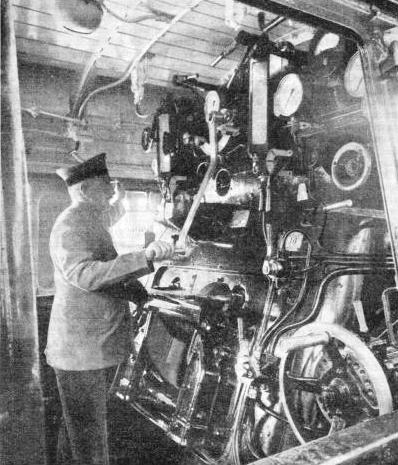
AT THE CONTROLS of a German locomotive. On some of the modern German engines experiments have been made with the automatic stoking which is in common use on the large engines of North America. The driver in the above photograph has his hand on the regulator; the wheel in the right foreground is for varying the cut-off and reversing the engine.
The next development was to fit inside the firebox what is known as a “thermic syphon” of the Nicholson type, consisting of a narrow wedge-shaped water-space, arranged vertically in the middle of the inner firebox and communicating by a pipe with the water space at the back, which not only increases the heating surface in the hottest position, but also facilitates the circulation of water in the firebox. As is customary with modern French locomotives, an “ACFT” feed-water heater was mounted above the boiler barrel, just behind the chimney.
The old piston-valves of the high-pressure cylinders and the poppet-valves of the low-pressure cylinders were removed, and Lentz double-beat poppet-valves were substituted, driven by oscillating cams off two sets of Walschaerts valve-gear, to give independent control of the cut-off in the high- and low-pressure cylinders, as is customary in the de Glehn compound arrangement. In certain later reconstructions new piston-valves of the Willoteaux type have been fitted and have also proved very successful.
Other modifications included the provision of new driving axles with balanced webs to the cranks, lightened motion parts. and forced lubrication for the cylinders to meet the higher superheat temperature conditions. Externally, the result of the reconstruction can hardly be described as beautiful, but in locomotive work “handsome is as handsome does”, and on this basis the rebuilt Paris-Orleans “Pacifics” are handsome engines indeed.
It was in 1929 that the first reconstruction was completed. The engine in question was No. 3566, subsequently renumbered 3701, and now No. 231.701. The Paris-Orleans-Midi Company has recently adopted the descriptive method of numbering, whereby the first three significant figures indicate the wheel arrangement of the locomotive (“231” for 2-3-1 in axles, or, as it would be described in Great Britain by wheels, 4-6-2), and the remaining figures the number of the engine, 701 of the “Pacific” type. Shortly after rebuilding, this locomotive was attached to a train of 468 tons, for a run from Les Aubrais Station at Orleans to Nantes and Redon. The 69·6 miles from Les Aubrais to St. Pierre-des-Corps (Tours) were covered in 64 minutes 30 seconds, notwithstanding a service slack to 55 miles an hour at Blois, and a relaying check to 20 miles an hour through Beaugency. Then came a time of 64 minutes 25 seconds for the 67·7 miles from St. Pierre to Angers, inclusive of two bad checks, to 20 and 25 miles an hour, on the way. The two subsequent runs were not quite so fast, because of numerous checks.
On a second test the engine developed an average indicated horse-power of 2,620, and an average horse-power at the drawbar of 1,500. At one point an indicated horse-power of 1,670 was recorded while the engine was travelling at 82 miles an hour. All these are exceptional figures for a locomotive of such size and weight. No. 3783, the second engine to be converted, and with the Willoteaux piston-valves in place of Lentz poppet-valves, developed an indicated horse-power of 2,615 when running at 74½ miles an hour, and cutting-off at 60 per cent of the stroke in the high-pressure cylinders, notwithstanding which the boiler was finding sufficient steam without difficulty. No. 3566 (later 231.701) showed a drawbar horse-power of 2,107 at one point, which until then was probably a world’s record for an engine of this weight.
Recovering Lost Time
But it is not merely on the tests, when conditions as nearly as possible perfect may be expected, that these engines have done well. Details were published in a French transport paper recently of a run on the 8.40am express from Paris to Bordeaux, which is always in summer a very heavy train, and on this occasion was made up to seventeen cars weighing no less than 784 tons, hauled, without assistance, by rebuilt “Pacific” No. 3717 from St. Pierre-des-Corps onwards. In the earlier stages of the run this vast train was worked along level stretches of track at 67 miles an hour, and the climbing included such achievements as an average speed of 56 miles an hour, and a minimum of 52½, up seven miles inclined at 1 in 225.
Time was being kept, and slightly improved on, when there was an unexpected happening. When the regulator was opened to start this enormous load away from Angoulême, the strain proved too much for one of the couplings in the train, which broke. Unfortunately it was a large brake-van that was thus put out of action; two other vans had to be substituted, to give the same accommodation, and after all the luggage had been transferred. the express restarted at Angoulême, now 28 minutes late, and made up to 807 tons. The driver was heard by an observer on the footplate merely to remark laconically to his fireman, “We shall have to work”, and work they and the engine certainly did, in most astounding fashion.
Up the climb to Charmant Tunnel, varying in steepness chiefly between 1 in 250 and 1 in 192, the speed was maintained steadily at 53 to 54 miles an hour, and the summit point, 15·5 miles from Angoulême, was passed in just over 21 minutes, with the engine cutting off at 60 per cent in the high-pressure and 58 per cent in the low-pressure cylinders, and a super-heat temperature of 700 degrees Fahrenheit. Speed ranged between 71 and 78 miles on the easier section between Charmant and Montmoreau, and the 50·6 miles from Angoulême to Coutras, scheduled to be covered in 57 minutes, were completed in 50 minutes from start to stop. In all, the locomotive regained 22 minutes between St. Pierre-des-Corps and Bordeaux, of which 15 minutes were recouped alone along the stretch south of Angoulême.
As an instance of high-speed work with lighter loads, the present writer has the liveliest recollections of a journey from Bordeaux to Paris, on the northbound “Sud Express”, which had started very late from the Spanish frontier. Signalled 49 minutes late from Lamothe, the last stop before Bordeaux (on the electrified Midi section), it arrived 45 minutes, and left for Paris 43 minutes late.
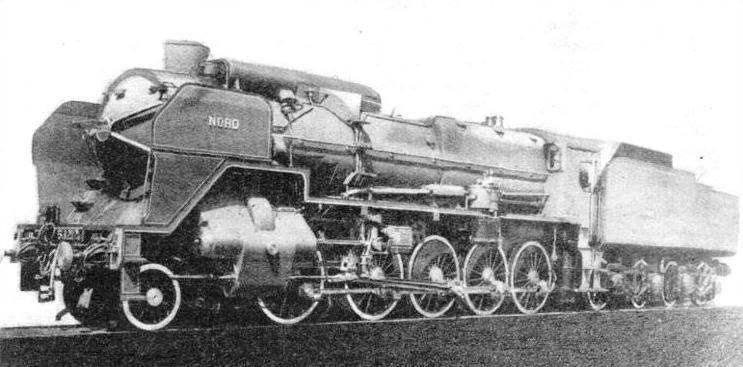
2-10-0 FREIGHT LOCOMOTIVE recently introduced on the Northern Railway of France for haulage of coal trains weighing over 2,160 tons at speeds of 40 miles an hour on the level. This type of engine has two high-pressure cylinders 19¼-in by 25¼-in, and two low-pressure cylinders 26¾ by 27½-in. The driving wheels have a diameter of 5 ft 1-in, the heating surface is 2,108 sq ft, and superheating surface 656 sq ft. Fire-grate area is 37½ sq ft and working pressure 261 lb per sq in.
With only three Pullman cars, and two large brake-vans, weighing 225 tons all found, this was not a big task from the haulage point of view, but the way in which time recovery was tackled without exceeding the French speed limit of 120 kilometres (74½ miles) an hour was astonishing. From Bordeaux to Les Aubrais No. 3709, one of the rebuilt “Pacifics”, recovered 36¼ minutes, and that on what was then one of the four fastest long-distance train schedules in the world, although some of the regained time was lost again by permanent way slowings. A total of 330 kilometres (205 miles) was covered at an average of 70 miles an hour. The running times for the 286·2 miles from Bordeaux to Les Aubrais totalled 264 minutes 54 seconds, and the net times, allowing for checks, but not for five service slacks through curves at stations, 257 minutes. Many other striking examples of modern Paris-Orleans locomotive work might be quoted did space permit.
The success of these reconstructions suggested the desirability of rebuilding some further engines on similar lines to work over the heavy gradients of the Paris-Orleans main line through Central France. A “Pacific” of another series. with smaller driving wheels, was therefore taken, and to give increased adhesion weight, the rear pair of carrying wheels under the firebox was removed, and a fourth pair of coupled wheels was substituted. The locomotive was thus converted to the
4-8-0 wheel arrangement, and the adhesion weight was increased from 51¼ to 73¾ tons.
The same alterations were made as in the converted “Pacifics”, including larger steam passages, double exhaust and chimney, Nicholson thermic syphon in the firebox, and cam-operated poppet-valves to the cylinders; but the additional pair of coupled wheels at the rear end necessitated a modification in the shape of the fire-grate, which now became long and narrow.
As rebuilt, the engines of this series have two high-pressure cylinders 17¼-in diameter, and two low-pressure cylinders 25¼-in diameter, with a common stroke of 25¼-in; driving wheels, 5 ft 11-in diameter; a total heating surface of 2,252 sq ft, and a superheating surface of 652 sq ft; a fire-grate area of 40½ sq ft; and the high working pressure of 290 lb per sq in. When working compound the tractive effort of this locomotive reaches a maximum of 45,930 lb, and when working simple, on starting, 57,470 lb. Yet these high figures are secured at the cost of a total engine weight, in working order, of 104½ tons - roughly equal to the LNER 2-8-2 engine, “Cock o’ the North” (whose design is in some ways based on this French engine), or one of the LMS “Pacifics” of the “Princess Royal” class.
Effect of Reconstruction
Some amazing performances stand to the credit of the twelve locomotives of this class, and it is probable that they are unsurpassed by any other engines of corresponding weight. Cutting off in the high-pressure cylinders at 55 per cent, one of these PO 4-8-0’s has attained the unprecedented drawbar horse-power, at so high a speed as 75 miles an hour, of 3,060, and it has been found possible to maintain round about 2,800 drawbar horse-power continuously at speeds varying between 40 and 80 miles an hour.
A maximum indicated horse-power of 3,050 has been secured, and the average horse-power output, when the engine is working hard, is in the region of 3,450, as compared with a little less than 2,100 before conversion, To have achieved such a result with no greater increase in the weight of the engine than from 90½ to 104½ tons is obviously an achievement which reflects the greatest credit on the designer and his staff,
But perhaps the most outstanding feats were recorded when rebuilt engine No. 4707 of this class was lent for trial purposes to the Northern Railway, and worked special test trains between Calais and Paris. The final trial consisted of working a train of 635 tons weight (equal to about twenty standard corridor coaches of the latest type of the LMS) from Calais to Paris.
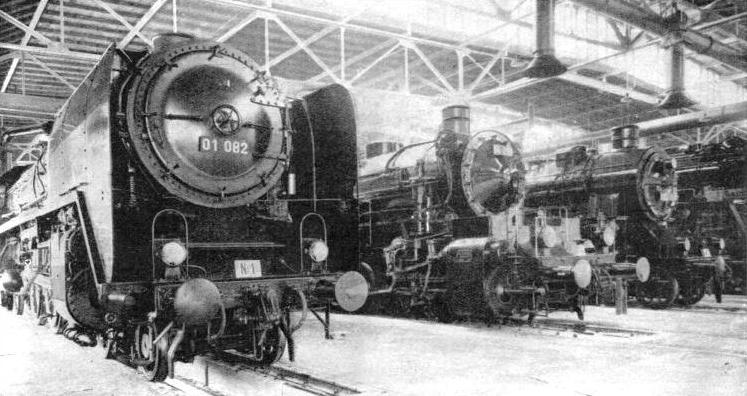
MODERN GERMAN LOCOMOTIVES tend to increase in size. Above are three powerful, recently built engines. On the left is a modern “Pacific” express engine, in the centre a “Mallet” type compound locomotive, and on the right one equipped for burning patent fuel.
Up the long 1 in 125 ascent from Calais to Caffiers, which was begun at 58½ miles an hour, the lowest speed recorded was 51 miles an hour, and, notwithstanding the tremendous effort of the engine, which was cutting off in the high-pressure cylinders at 50 per cent, pressure remained constant at 290 lb. When the train attained the level stretch beyond Etaples, inclusive of a slack to 65 miles an hour through Abbeville, 46½ miles were run at an average rate of 79·7 miles an hour, which meant a running speed of over 80 miles an hour for almost the whole distance. The 102·9 miles from Calais to Amiens were thus run in 85 minutes 32 seconds, including Caffiers Summit, and the slight slowings at Boulogne, Etaples, and Abbeville. Then, after leaving Amiens, up the sections of the gradual climb to Gannes that are inclined at 1 in 333 (exactly the same inclination as the rise on both sides of the LMS main line to Tring Summit) the engine maintained 73½ miles an hour. The long 1 in 200 ascent to Survilliers (equal in inclination to the ascent from Wood Green to Potter’s Bar on the LNER) was surmounted with the speed steady between 68½ and 71 miles an hour. Down the far side, also on a 1 in 200 grade, speed rose to 90¾ miles an hour - notwithstanding eight-coupled wheels of no more than 6 ft 1-in diameter. The French speed limit of 74½ miles an hour had been temporarily waived.
Thus the 77·3 miles from Amiens to passing St. Denis were covered in 63 minutes 25 seconds, at an average of 73·1 miles an hour, to which may be added the 72·2 miles an hour already maintained from Calais to Amiens. A non-stop run from Calais to Paris, on this basis, would have taken about 154 minutes, whereas the northbound “Golden Arrow”, the fastest existing train on the service, is allowed 187 minutes.
It is not surprising, in the circumstances, that twenty of the Paris-Orleans “Pacifics” displaced by electrification should now have found their way to the Nord system. Ten similar engines are being handed over to the State Railways.
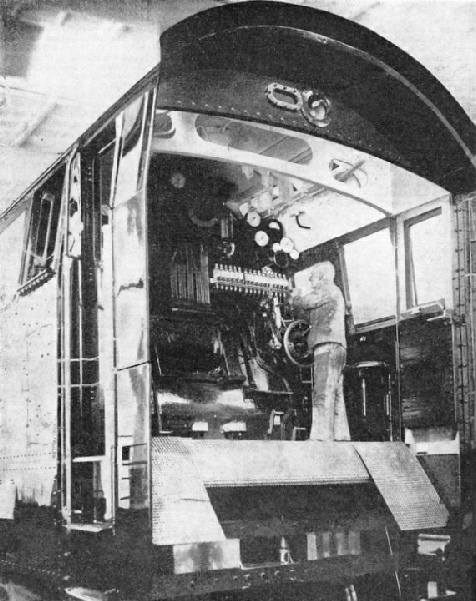
DWARFING THE DRIVER. This is the huge engine cab of a German streamlined locomotive designed to haul a load of 256 tons at over 100 miles an hour. All the latest developments in locomotive streamlining have been embodied. The metal casing reaches practically down to rail-level. The bottle-shaped containers beneath the gauges are oil-indicators which enable the driver to see that lubricant is being properly distributed.
In Germany, the policy of the administration, since the grouping of the German railways into one system after the war of 1914-1918, has been towards standardization, with as few standard classes of engine as possible.
German Practice
Express passenger service is conducted with various groups of “Pacific” locomotives. In the latest “O.4” series, by the use of special alloy steels in the building of the boiler, the working pressure has been increased at one bound from 228 to the high figure of 356 lb per sq in, and the cylinders, in consequence, have been reduced in diameter from the previous 18-in (high-pressure) and 28¼-in (low-pressure) to 13¾-in and 20½-in respectively, the stroke of all four cylinders remaining 26-in.
Driving wheels are 6 ft 6¾-in in diameter; the heating surface of the “O.4” series, 2,226 sq ft, compares with 2,659 sq ft in the “O.2” engines, and 911 sq ft of superheating surface with 926 sq ft; the firegrate area is also reduced in the later series from 48½ to 44 sq ft. As a result of these modifications, and the use of the alloy steels, the weight of these “Pacifics”, without tenders, has been reduced from 112 to 102 tons. Engines of the new type have been tested up to 93 miles per hour, and successfully handle trains up to 600 tons.
To the patient research work of Dr. Schmidt, the German locomotive engineer, the world in general owes the progress that has been made in locomotive superheating. But his later experiments in the direction of ultra-high-pressure locomotives, which have been tried in Germany as in other countries, have not met with the same success and extensive adoption, probably for the reason that the maintenance in running order of engines carrying these enormous steam pressures has proved so costly.
In Germany, as in France and Great Britain, the normal steam locomotive appears still to offer a fruitful field for development, by close study of the considerations bearing on efficiency, without making radical changes in design which, while the engine may do its work, prove so costly in construction and upkeep that no advantage is obtained. And the competition of other prime movers, such as the Diesel engine and electric traction, has so stirred up the locomotive designers as to make it tolerably certain that the steam locomotive has still before it a long lease of life.
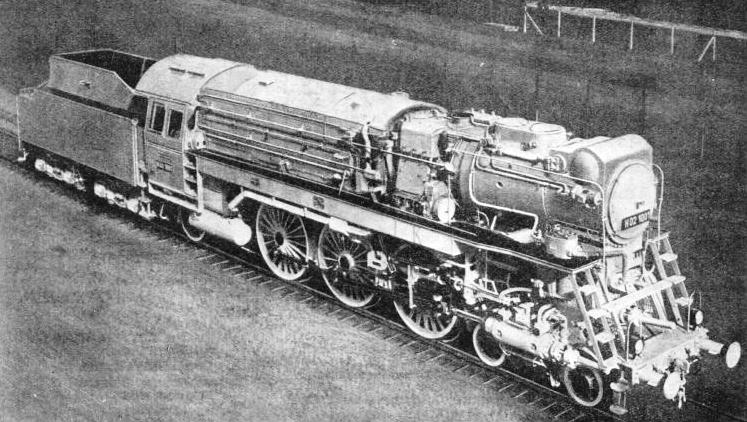
A STEEL COLOSSUS. This 4-6-2 locomotive was built experimentally for the German State Railways to utilize steam at a pressure of 1,470 lb per sq in and over. Many trials in ultra-high-pressure locomotives have been made in Germany, but the maintenance costs of locomotives with enormous steam pressure have so far proved uneconomically high.
You can read more on “Electrification in Europe”, “From Brittany to the Rhine”, “The Northern Railway of France”, “Some German Achievements” and “Speed Trains of Europe” on this website.











